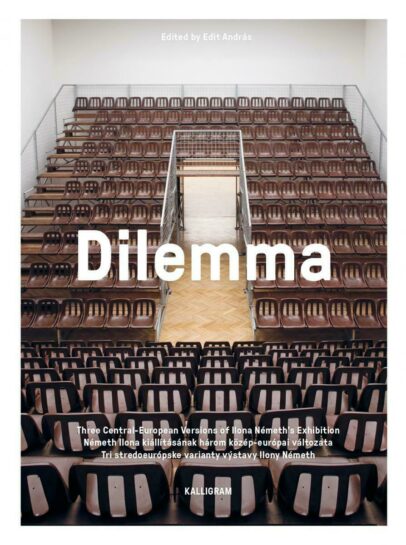The Harpoon Project – Site Specific for New Bedford
The Harpoon Project, 2013
Site-specific installation, dimensions variable, 1100 ceramic harpoons
The Harpoon Project, 2013
Site-specific installation, dimensions variable, 1100 ceramic harpoons

Dilemma, 2013
Edited by Edit András
A touring exhibition of one of the most important representatives of contemporary art in the Central and Eastern European region was at all its sites (Budapest, Košice, Brno) at home and, at the same time, a guest; in all the sites it was a statement made from both the inside and the outside, corresponding to the transnational position of the artist. Ilona Nemeth is a Slovak artist of Hungarian nationality, whose artistic career began in Czechoslovakia, who regularly exhibits in Slovakia as well as in the Czech Republic, and who is also considered part of the Hungarian art scene.
Read moreRetour, 2013
In cooperation with Jonathan Ravasz
Object
80 x 30,5 x 30,5 cm
30 postcards in a metal postcard stand
Photos by the artist
Postcard photos by Gábor & Ádám Hushegyi
“The billowy history of Hungary since the political transformation in the early 90’s includes the relationship among Hungarians and Hungarians living abroad which is rather quiet troubled and unsettled. The mother country feels its own historical and moral obligation to interfere into the life of the communities beyond the borders which brings some positive but at the same time some dysfunctional consequences.
Read moreThe Fog, 2013
September 12 and September 27, 2013
Námestie Slobody / Freedom Square, Bratislava
Performance
Organised by Verejný podstavec / Public Pedestal, Bratislava
In cooperation with Martin Piaček
Realized within project Zero Point
Production by Petra Báliková
Photos by Marian Ravasz
The Fog
Video (5’20”)
Video production by Cukru
Director of photography and editing by Martina Slováková
Photos by Miroslav Bača, Martin Chlpík, Jakub Lazarčík, Dušan Vančo
Sound by Blažej Vidlička
Sound design by Dušan Vančo
Special effects by František Šuli Rakický, Gabriela Macková
Production management by Petra Báliková, Martin Piaček
Supported by Ministerstva kultúry SR
“No One Left”, 2013
Location: in front of the Műcsarnok/Kunsthalle, Budapest, Hungary
Public performance
Performance text by Martin Niemöller (1892-1984)
“First they came for the Socialists, and I did not speak out— Because I was not a Socialist. Then they came for the Trade Unionists, and I did not speak out— Because I was not a Trade Unionist. Then they came for the Jews, and I did not speak out— Because I was not a Jew. Then they came for me—and there was no one left to speak for me.”
Realized within In the framework of the protest project “Outer Space – Stand Out Every Week” (web)
Organised by Eszter Kozma, József Mélyi, Márton Pacsika
Photos by Zsuzsanna Simon
Real Estate Advertisement, 2013
Location: in front of the Műcsarnok/Kunsthalle, Budapest, Hungary
Public performance
Realized within In the framework of the protest project “Outer Space – Stand Out Every Week” (web)
Organised by Eszter Kozma, József Mélyi, Márton Pacsika
Photos by Zsuzsanna Simon
Szelmenc / Slemence / Селменці, 2013
Performance
Performance location: X-Apartments, Košice, Slovakia
In cooperation with Goethe Institut Bratislava
In cooperation with Károly Tóth
Photos by Anton Baša
Szelmenc / Veľké Slemence / Селменцi, 2013
Installation, dimensions variable
Slide show, photographs, sounds and candy
“Ilona Németh [sa] pokúša zachytiť širšie súvislosti historicko-politických a kultúrnych zmien prostredníctvom konkrétnych príbehov a osobných histórií hlavných aktérov jej diel.
Read more2013
Work in progress
59,4 x 84,1 cm
Paper, mixed media
Košice, 2013
Public art
535 x 788 cm
Mirrors, metal construction, hardboard
Location: Námestie Osloboditeľov, Košice, Slovakia
Architect: Marián Ravasz
Photos by the artist
Capsules, Žilina, 2013
Unrealised public space project for Kunsthalle Žilina
Column, Žilina, 2013
Unrealised public space project for Kunsthalle Žilina
Floating Gardens, Košice, 2013
Object in public space
300 x 400 x 90 cm (2 pieces)
Polypropylene (PP) objects, plants, natural materials
Location: Tyršovo nábrežie, Košice, Slovakia
Rent a garden for free
A garden sized 3,5 x 4,5 metres is available for rent at the Mlynský náhon, Tyršovo nábrežie, Košice, Staré mesto, from May 1 to October 30, 2013, for free in return for the keeping of the plants.
In cooperation with Marián Ravasz, architect & Zsolt Bankó, garden architect